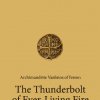CNN's Paula Newton tours Belgrade's royal palace and explores the country's religious identity
.A great man is one who collects knowledge the way a bee collects honey and uses it to help people overcome the difficulties they endure - hunger, ignorance and disease!
- Nikola Tesla
Remember, remember always, that all of us, and you and I especially, are descended from immigrants and revolutionists.
- Franklin Roosevelt
While their territory has been devastated and their homes despoiled, the spirit of the Serbian people has not been broken.
- Woodrow Wilson
Latest Articles
- Crafting Pišanice - Serbian Easter Eggs with Natural Dyes
- From Nicaea to Today: The Enduring Legacy of Synodality and Unity in the Church
- The Role of the Deacons in the Church
- The Circle of Serbian Sisters
- Vinka Ellesin
- Богородица као екстатично биће
- Bishop Maxim's Homily During the Assembly of Bishops XII Opening Liturgy
- Leon Joseph Lysaght Jr.
- Olga Gradojevich
People Directory
Lolita Davidovich
Lolita Davidovich (Serbian: Лолита Давидовић; born July 15, 1961) is a Canadian film and television actress.Davidovich was born in London, Ontario, the daughter of immigrants from Yugoslavia. Her father was from Belgrade, the capital of Serbia, and her mother was from Slovenia; she spoke only Serbian during her early years. She studied at the Herbert Berghof Studio in New York.
. Read more ...Publishing
The Thunderbolt of Ever-Living Fire
by archimandrite Vasileios of IveronThe present book consists of Elder Vaileios' talks, discussions and dialogues in various venues mostly in the United States during his visit in 2011, along with excerpts from his writings selected to complement the themes of his talks. The themes dealt with by Fr. Vasileios so eloquently in this book are extraordinarily wide-ranging; he handles complex and difficult issues in theology, spirituality, liturgics, parish life and monasticism with amazing clarity and insight. He quotes with equal facility from figures as diverse as Heraclitus, Dostoevsky, St. Isacc the Syrian, St. Maximus the Confessor, Stefan Zweig, Andrei Tarkovsky, Vladimir Lossy, Georges Florovsky and St. Nicholas Cabasilas. Above all, there is an exhilarating sense of freedom and innocence in his thought. It is the freedom and innocence of profound faith and spiritual knowledge and childlike simplicity. HIs wisnow is expressed via the "hyperlogic" of a hesychastic spriti, which makes for surprising connections and illuminating insights.
The appearance of this new book by Archimandrite Vaileios is truly a cuase for celebration.
143 pages
ISBN: 978-1-936773-16-9
Latest US News
- Волт Богданић: Американац српског порекла добитник три Пулицерове награде за истраживачко новинарство
- The American Srbobran - Building a Partnership with the Library of Congress and Institutions in Serbia
- „Американски Србобран“ унапређује сарадњу са Конгресном библиотеком у Вашингтону и институцијама у Србији
- Преминуо чувени амерички песник српског порекла Чарлс Симић
- Јован Дучић међу великанима у кливлендској башти
- Србија, Африка, Америка и Канада славе дан Теслиног рођења
- Документарац Немање Станковића приказан у Холивуду
- Tesla Rhapsody
- Saved by Beauty: Dostoevsky in New York
- Izložba likovnih radova o Dostojevskom
- Steve Popovich - the man who discovered Meat Loaf
- Odlazak čoveka koji je mnogo uradio za očuvanje sećanja na lik i delo Nikole Tesle
- Naš otac Balkanac za Ruse je smislio bijelu Coca-Colu
- Neverovatan poduhvat srpske pravoslavne zajednice u Americi
- Prva Srpkinja u finalu najveće evropske nagrade za pronalazače
Latest Serbia News
- На Станфорд листи 15 крагујевачких научника
- Naše postojanje skriva mračne i svetle strane, i veliko je umeće prepoznati ih i razlučiti
- Српска застава је најлепша на свету – на основу резултата анкете милион људи
- Недеља америчке културе
- Preminuo pisac Aleksandar Petrov
- Spomenik Branku Pešiću radiće srpski vajar iz Los Anđelesa
- Metropolitan Amfilohije buried in the Cathedral church in Podgorica
- Memorial prayer rite for Metropolitan Amfilohije in the Cetinje Monastery
- На данашњи дан рођен је Михајло Идворски Пупин
- Алекса је стигао до Принстона, али Математичкој гимназији се радо враћа
- Каубој православац и 40 Американаца посетили Косово
- Архив Војводине: Сведочанства времена у спомен на херојске претке
- Премијера „Теслиног народа“ на Коларцу
- Када се велики умови играју науком о подацима
- Američka vojska donirala je vrednu opremu klinici u Nišu




